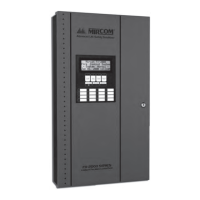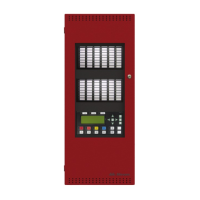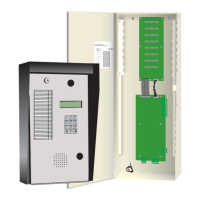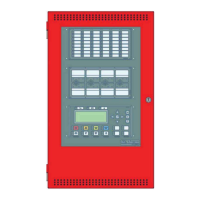OPERATING INSTRUCTIONS
72
Buzzer
Draws attention that a change of state has occurred. A fast beep indicates an alarm
condition, and slow beep indicates all other events.
Alarm indicators
The Red indicators illuminate/flash on detection of an alarm condition. Rapid flashing
indicates new alarms, slow flashing indicates cleared alarms, and steady-on to
indicate acknowledged alarms.
LCD
Displays event history and maintenance mode selection. The LCD is the most
important part of the PRO-2000 User Interface. It can either display system
information or guidance on how to interact with the system.
For example, a typical message displayed during an alarm:
Alarm # 1 of 3 <NEW> HH:MM:SS
Protected Area Name (user defined)
Where:
Alarm # 1 of 3 means that this is the first of three alarms detected by the system.
<NEW> means that this alarm was detected but not acknowledged or cleared.
HH:MM:SS is the time at which the alarm signal was picked up.
Protected Area Name identifies the device/zone in alarm. This message is user
defined.
Reset push button
Acknowledges the currently displayed alarm, supervisory, trouble, or status event.
Security access level protected.
Acknowledge push button
Resets the currently displayed alarm, supervisory, trouble, and status event and
silences the buzzer. Security access level protected.
Supervisory indicator
The Yellow indicator illuminates when a Supervisory condition has been detected.
Flashing indicates a new event, steady-on indicates an acknowledged event.
Control Enabled indicator
The Yellow indicator illuminates steady-on when the current access level is set to 1.
The indicator flashes when the current access level is set to 2.
Panel Failed indicator
The Yellow indicator illuminates when the Panel electronics have failed and cannot
sustain normal operation. When illuminated, the buzzer turns ON and can be silenced
using the Acknowledge button. All other keys are inactive.
Power On indicator The Green indicator illuminates whenever the system is powered on.
Control Key
Sets the security level of the system to level 1 when ON, level 0 when OFF. Provides
control over who can Acknowledge/Reset the system. Prevents tampering by
unauthorized personnel.
Table 28: System Status
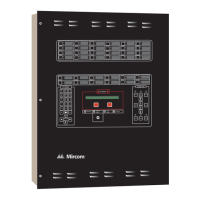
